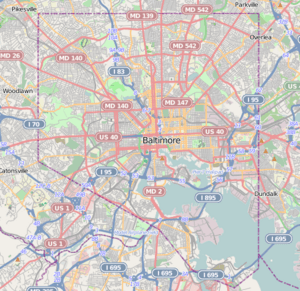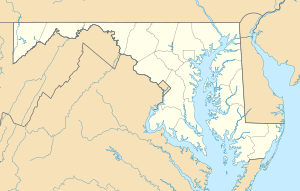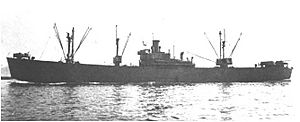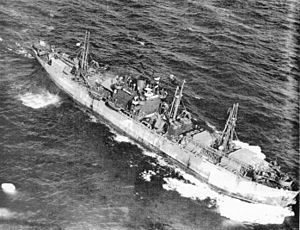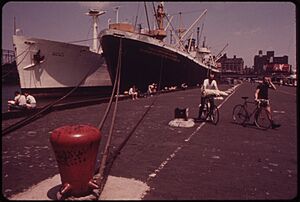SS John W. Brown facts for kids
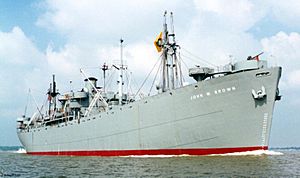
SS John W. Brown on the Great Lakes in 2000.
|
|
| History | |
|---|---|
| Name | John W. Brown |
| Namesake | John W. Brown (1867–1941), Canadian-born American labor union leader |
| Ordered | 1 May 1941 |
| Builder | Bethlehem-Fairfield Shipyard, Sparrows Point, Maryland |
| Laid down | 28 July 1942 |
| Launched | 7 September 1942 |
| Sponsored by | Annie Green |
| Completed | 19 September 1942 |
| Acquired | 19 September 1942 |
| In service | 19 September 1942 |
| Out of service | 19 November 1946 |
| Identification |
|
| Honors and awards |
|
| Fate |
|
| Status | Seagoing museum ship operated by Project Liberty Ship |
| General characteristics | |
| Class and type |
|
| Tonnage |
|
| Displacement | |
| Length |
|
| Beam | 57 feet (17 m) |
| Draft | 27 ft 9.25 in (8.4646 m) |
| Installed power |
|
| Propulsion |
|
| Speed | 11.5 knots (21.3 km/h; 13.2 mph) |
| Range | 23,000 miles (20,000 nmi; 37,000 km) |
| Capacity | 562,608 cubic feet (15,931.3 m3) grain (as cargo ship) |
| Troops | Up to 450, 550, or 650 (sources) as "Limited Capacity Troopship" |
| Complement |
|
| Armament |
|
| Notes | As of September 2007, the bow 3-inch gun and several 20-mm cannon were rigged with compressed gas firing simulators (oxygen and a fuel gas) for historical re-enactments of air defense |
|
SS John W. Brown (Liberty Ship)
|
|
| Location | Pier 1, Clinton St., Baltimore, Maryland |
| Built | 1942 |
| Architect | Bethlehem-Fairfield Shipyard, Baltimore, Maryland |
| NRHP reference No. | 97001295 |
| Added to NRHP | 17 November 1997 |
The SS John W. Brown is a special kind of ship called a Liberty ship. She is one of only two Liberty ships still able to sail today. She is also one of three that have been saved as museum ships. During World War II, she was a merchant ship for the United States Merchant Marine. After the war, she became a high school training ship in New York City. Today, she is a museum ship and a cruise ship. You can find her at Clinton Street Pier 1 in Baltimore Harbor, Maryland.
The John W. Brown was named after John W. Brown. He was a Canadian-born American labor union leader who lived from 1867 to 1941.
Another Liberty ship that can still sail is the SS Jeremiah O'Brien. She is in San Francisco, California. A third Liberty ship, SS Hellas Liberty (formerly SS Arthur M. Huddell), is a museum ship in Piraeus, Greece.
Contents
Building the John W. Brown
The United States Maritime Commission ordered the John W. Brown on May 1, 1941. She was planned as a cargo ship, which became known as a "Liberty ship." Her hull number was 312.
The ship was built at the Bethlehem-Fairfield Shipyard in Baltimore, Maryland. Her construction started on July 28, 1942. Annie Green, the wife of a union president, helped launch the ship on September 7, 1942. She was one of three Liberty ships launched that day.
The John W. Brown was finished on September 19, 1942. It took only 54 days to build her! The ship cost about $1,750,000. She was the 62nd Liberty ship built at that shipyard. Her steam engine was built by Worthington Pump & Machine Corporation. It cost $100,000.
Life at Sea: World War II Missions
The John W. Brown was given to the Maritime Commission when she was finished. She was operated by States Marine Corporation and later by the United States Army.
After more work in Baltimore, the ship left on September 29, 1942. She went to Norfolk to get ready for war. This included special treatments to protect her from magnetic sea mines.
On October 6, 1942, she began loading her first cargo in New York City. This cargo was for the Soviet Union. It included two Curtiss P-40 Warhawk fighter planes, 10 M4 Sherman tanks, 200 motorcycles, and 100 jeeps. She also carried over 700 tons of ammunition and canned pork. While in New York, she received a new 3-inch (76.2-mm) gun on her bow.
First Voyage: To the Persian Gulf
The John W. Brown started her first voyage on October 15, 1942. She was headed for the Persian Gulf to deliver her cargo. Her route was very long, about 14,400 nautical miles (26,667 km). This long route helped her avoid areas where Axis forces were a big threat.
She sailed in convoys down the U.S. East Coast to Guantánamo Bay, Cuba. Then she crossed the Caribbean Sea to the Panama Canal. After the canal, she sailed alone down the west coast of South America. It took two weeks to reach Cape Horn. She then crossed the South Atlantic to Cape Town, South Africa, to refuel.
She finally reached the Persian Gulf on December 25, 1942. This was two and a half months after leaving New York. The ports there were very busy. So, the John W. Brown had to wait a month to unload. She dropped off some cargo in Abadan in January 1943. The rest was unloaded in Khorramshahr, Iran, in March 1943.
On March 16, 1943, she began her return trip. She stopped in Cape Town again. Then she sailed to Bahia, Brazil, arriving on April 23, 1943. She joined convoys to load bauxite in Surinam and Trinidad. Finally, she arrived back in New York City on May 27, 1943. Her first voyage lasted about eight months!
Becoming a Troopship
Her first voyage was her only one as a regular cargo ship. After returning, the John W. Brown was changed into a "Limited Capacity Troopship." She was the first of 220 Liberty ships to get this change. She could now carry between 450 and 650 troops or prisoners.
These changes happened at Bethlehem Shipbuilding Corporation in Hoboken, New Jersey. They added bunk beds for passengers. They also added more showers, generators, and two more 20-mm automatic cannons.
For her second voyage, she carried 306 men. These included U.S. Army officers and Royal Navy sailors. She also carried 5,023 tons of food. She left New York on June 24, 1943. She sailed in a convoy across the Atlantic. On July 18, 1943, she entered the Mediterranean Sea. She arrived in Algiers, French Algeria, on July 20, 1943.
After unloading, she took on 500 German prisoners-of-war. These were soldiers from the Afrika Korps. She departed Algiers on August 5, 1943. She returned to Hampton Roads, Virginia, on August 26, 1943. The trip was safe, with no enemy attacks.
More Wartime Journeys
For her third voyage, the John W. Brown carried TNT, gasoline, and other cargo. She also had 339 U.S. Army personnel as passengers. She left Hampton Roads on September 15, 1943. She arrived in Oran, French Algeria, on October 4, 1943.
She then took on 346 men from the U.S. Army's 1st Armored Division. She also loaded 274 of their vehicles, including 61 tanks. She made eight short trips in the Mediterranean Sea. She visited places like Naples, Italy, and Bizerte, Tunisia.
On December 27, 1943, another ship, the SS Zebulon Pike, hit the John W. Brown. This caused damage to her side. But she kept going! She continued her missions, carrying troops and supplies.
On February 21, 1944, she left Bizerte to return to the U.S. The next day, a German submarine attacked her convoy. Two other Liberty ships were hit and badly damaged. But the John W. Brown was unharmed. She arrived back in New York on March 17, 1944. She then went for repairs and had more guns installed.
Her fourth voyage started on April 10, 1944. She carried explosives and sailed to Naples, Italy. She was present at the Anzio beachhead when Allied forces broke out. She transported German prisoners and Allied troops. She also took part in Operation Dragoon, the invasion of southern France, in August 1944. She arrived off the French coast on August 15, 1944. During this time, there were many German air attacks.
The John W. Brown completed her fourth voyage on September 30, 1944. She returned to Baltimore.
She continued her important work through several more voyages. She carried troops, supplies, and even mail. She sailed through rough weather and faced submarine threats. But she always completed her missions. By March 1945, she was still sailing strong.
On May 8, 1945, V-E Day (Victory in Europe Day) arrived. The war in Europe was over. The John W. Brown was off the coast of England. She then went to Antwerp, Belgium, and Le Havre, France. She brought back U.S. Army personnel, including some liberated prisoners. She arrived back in New York on June 11, 1945.
On August 15, 1945, V-J Day (Victory over Japan Day) marked the end of World War II. The John W. Brown's wartime service was complete.
After the War: A School Ship
After the war, the John W. Brown was changed again. Her troop-carrying space was increased. All her guns were removed by September 1945.
She made a few more voyages carrying grain and troops. She sailed to France and Denmark. Her last voyage ended on November 19, 1946. This marked the end of her active sailing career.
New York City needed a ship for its Metropolitan Vocational High School. This school trained students for careers at sea. In August 1946, the city borrowed the John W. Brown. She was perfect because her troop decks could be used as classrooms.
On December 13, 1946, she was towed to Pier 4 in Manhattan. She became the SS John W. Brown High School. It was the only floating nautical high school in the United States. She served as a training facility from 1946 to 1982. Thousands of students learned about seafaring careers there.
Students studied regular subjects in a building on land. Aboard the John W. Brown, they learned hands-on skills. They learned to be deck hands, engine room personnel, or stewards. They also helped maintain and repair the ship.
Graduates from the school were highly respected. Between 1951 and 1955, 80% of graduates found jobs in the maritime industry. This was a great success!
However, by the late 1950s, the school faced money problems. It was expensive to keep the John W. Brown running. In mid-1982, the school finally closed. The ship then sat idle in New York Harbor.
Saving a Piece of History
When the school closed, a group called Project Liberty Ship formed. They wanted to save the John W. Brown. But they couldn't find a place for her in New York. So, in July 1983, she was towed to the James River Reserve Fleet in Norfolk. Her future was uncertain.
In August 1988, Project Liberty Ship found a new home for her in Baltimore. This was near where she was built! In September 1988, she became a memorial museum.
After three years of hard work, the John W. Brown sailed again. On August 24, 1991, she moved under her own power for the first time in almost 45 years. She completed sea trials in the Chesapeake Bay. On September 21, 1991, she took about 600 people on her first cruise as a museum ship.
In 1994, she was approved for ocean voyages. She sailed to New York Harbor in April 1994. In August 1994, she made her first foreign trip as a museum ship. She visited Halifax, Canada. She also stopped in Boston and Greenport, New York.
The John W. Brown was added to the National Register of Historic Places on November 17, 1997. In 2000, she visited the Great Lakes for repairs in Toledo, Ohio.
Today, the John W. Brown is a floating museum. She also offers "Living History Cruises" several times a year. These six-hour cruises go through Baltimore Harbor and into the Chesapeake Bay. On these cruises, you can tour the ship. You can learn about the U.S. merchant marine and Liberty ships in World War II. There are even reenactments of wartime activities. Sometimes, World War II planes do flybys!
As of 2013, she had completed 97 Living History Cruises. She had visited 29 ports along the U.S. East Coast, Canada, and the Great Lakes. She is the largest cruise ship operating under the American flag on the U.S. East Coast.
Honors and Awards
For her service in World War II, the John W. Brown received several awards:
Merchant Marine Combat Bar
 Merchant Marine Atlantic War Zone Medal
Merchant Marine Atlantic War Zone Medal Merchant Marine Mediterranean-Middle East War Zone Medal
Merchant Marine Mediterranean-Middle East War Zone Medal Merchant Marine Pacific War Zone Medal
Merchant Marine Pacific War Zone Medal Merchant Marine World War II Victory Medal
Merchant Marine World War II Victory Medal
As a museum ship, the John W. Brown has also received the World Ship Trust's Maritime Heritage Award.
- SS John W. Brown, Baltimore City, including photo from 1986, at Maryland Historical Trust
Images for kids


